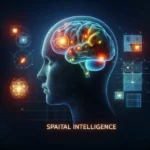Understanding Spatial Intelligence in IQ Assessments
When diving into the realm of intelligence quotients (IQ) and the various facets that these evaluations aim to measure, one notable component that often comes to the forefront is spatial intelligence. But what exactly is spatial intelligence, and how does it manifest within IQ tests? This article aims to shed light on this cognitive ability and its significance in standardized intelligence assessments.
Spatial intelligence, sometimes referred to as spatial reasoning or visuospatial ability, is the capacity to comprehend, reason, and remember the spatial relations among objects or space. Individuals with high levels of spatial intelligence are typically adept at visualizing and manipulating objects, often excelling in tasks that require these skills.
When it comes to IQ tests, spatial intelligence is evaluated through a series of tasks designed to measure one’s ability to manipulate images, construct three-dimensional models in the mind, and solve problems related to physical space. These tasks may take the form of puzzles, block design tests, and questions requiring the visualization of complex shapes and patterns.
The inclusion of spatial intelligence in IQ assessments is grounded in the idea that intelligence is multifaceted. Spatial ability is considered a critical component alongside other types of intelligence, such as logical reasoning, linguistic ability, and mathematical skills. Given that different individuals have varying strengths across these areas, measuring spatial intelligence allows for a more comprehensive evaluation of an individual’s cognitive abilities.
Why is spatial intelligence important? This particular cognitive skill is not just about solving puzzles on a test—it has real-world applications. Professionals in fields such as architecture, engineering, surgery, and graphic design rely heavily on their spatial intelligence to excel in their respective careers. Moreover, everyday tasks like navigating a new city, packing a suitcase, or assembling furniture all tap into one’s visuospatial capabilities.
IQ tests that assess spatial intelligence typically involve standardized, timed activities that challenge test-takers to demonstrate their spatial capabilities under pressure. These tasks may include:
1. Pattern Analysis: Identifying the next in a sequence of shapes or figuring out how a pattern would look when rotated.
2. Block Design: Assembling a set of blocks to match a particular pattern within a limited time frame.
3. Paper Folding: Envisioning how a folded, punctured paper would appear when unfolded.
4. Spatial Scanning: Finding a path through a maze or scanning for a specific symbol within a field of distractions.
The role of spatial intelligence in IQ tests is twofold: it complements other areas of intelligence to give a rounded picture of an individual’s cognitive capabilities, and it provides valuable insights into skills that are crucial for many practical tasks and professions.
In conclusion, spatial intelligence is a key element of the broader intelligence spectrum measured by IQ tests. By evaluating visuospatial abilities, these tests offer a glimpse into how individuals perceive and interact with the world around them. Such insights can not only guide educational and vocational direction but also improve our understanding of the diverse ways in which our minds operate. Whether in academia or industry, recognizing and fostering spatial intelligence remains a vital component of personal and professional development.

